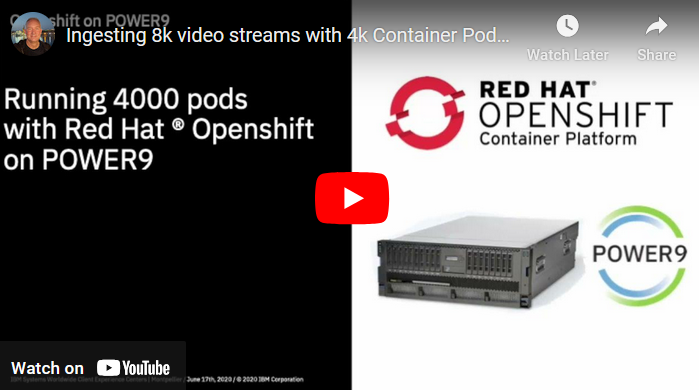Project Summary
A team of Power enthusiasts collaborated to create an infrastructure that could handle up to 800,000 video streams from home video security cameras. The customer wanted to scale economically using the least processor cores and server footprint.
Load Generator
Configuration
Due to local availability, two Power8 servers were used as Load Generators. Each load generator used one physical 10Gb port.

Power Config & Results
Power Landscape

Power Config
| Used IBM S924 server config | Target IBM L922 server config |
| 22 POWER9 cores | 20 POWER9 cores |
| 2048 GB RAM | 1024 GB RAM |
| 3 x 4 port SRIOV Ethernet 10Gbps | 3 x 4 port SRIOV Ethernet 10Gbps |
| Local disks / SAN disks | Local disks / SAN disks (TBD) |
| PowerVM | PowerVM |
The Power team created an environment similar to the target architecture, with the management nodes created in a Power8 server and worker nodes created in an S924 server.
To mimic the target L922 server as much as possible, they created a dummy partition with two dedicated cores that left the core count at 20 (as in the L922 server). The memory of the S924 was 2TB, which was helpful to start the tests without memory constraints.
Four quad-port SR-IOV 10Gbps adapter ports were used for the 10 Worker Nodes. It was noted that in production mode, one port per LPAR would be a better solution.
- 1.8 shared cores, uncapped.
- 96 GB RAM
- 150 GB disk
- RHEL
- One 10Gbps port from the 3 SRIOV adapters.
All Lpars were balanced between the two sockets during the tests to avoid problems.
One VIO Server was used to manage the disk I/O with the following specifications:
- One shared core (4 VPs), uncapped.
- 8 GB RAM
- 100 GB disk
- VIOS
Power Results
The Power Team achieved support of 2,500 containers (250 containers per LPAR).
Creating and ramping the 2,500 containers running on Power took just 41 minutes.

Summary
- The performance test was successful.
- The Power Team achieved the target of 2,500 containers in a single L922 server.
- The creation and ramp-up time to create 2,500 containers on Power was 41 minutes
- Power Servers include PowerVM with high-performing hardware Virtualisation providing superior performance built in. PowerVM provides a significant advantage when consolidating workloads and often significantly reduces software licensing costs.
- The POWER processor is extremely flexible and can operate in various (Single, 2, 4 and even 8) Symetritcal Multi-Threading modes. SMT configuration optimises for response time and or throughput.
Further Testing
Some months later, the Power team continued testing to see if the 20-core Power9 server could support an even higher workload. Indeed, the recording below demonstrates how they managed to deploy and ramp up the ingestion of 8,000 video streams using 4,000 Container Pods with 20 POWER9 processor cores.
It took just 12 minutes to create the Pods and another 16 minutes to fully ramp up to ingesting 8,000 video streams with OpenShift and Power9.
Can I help you?
Let me know if you would like any assistance.

Leave a Reply